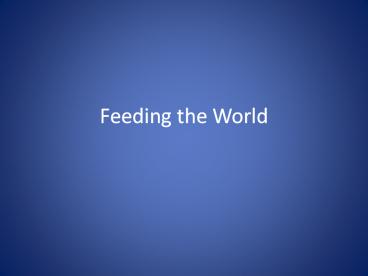Feeding the World - PowerPoint PPT Presentation
Title:
Feeding the World
Description:
Feeding the World – PowerPoint PPT presentation
Number of Views:126
Avg rating:3.0/5.0
Title: Feeding the World
1
Feeding the World
2
Sect. 1 Objectives
- Identify the major causes of malnutrition.
- Compare the environmental costs of producing
different types of food. - Explain how food distribution problems and
drought can lead to famine. - Explain the importance of the green revolution.
3
Nutrition
- What is good nutrition/a balanced diet?
- 4 food groups
- Dairy - calcium
- Protein
- Bread carbohydrates
- Fruits and veggies - vitamins
- My Food Pyramid
- mypyramid.gov
- What are Calories?
- How many should you have a day?
4
Malnutrition when someone does not eat enough
calories or different foods to fulfill the bodies
needs.
- Corn or Rice diets protein malnutrition
- Effects physical and mental development
- Majority of foods produced in the world are
carbohydrates
5
- https//www.youtube.com/watch?vL3abZswA5XY
- https//www.youtube.com/watch?v7-0y_H7OGgQ
6
(No Transcript)
7
Ecology of Food
- Food efficiency
- energy resources FOOD
- Cow 1,000,000 calories per acre
- Corn 2,000,000 calories per acre
- Potatoes 8,500,000 calories per acre
- Which has the highest yield?
- What would you plant to feed a large population?
8
World Food Problems
- The world currently produces enough grain to feed
10 billion people. - People eat too much
- People want meat
- Poverty
- More money more technology/equipment more
food
9
Impact on Environment
- Livestock vs. Grains
- What are livestock fed?
- Where is that grown?
- What is the yield?
10
The Green Revolution
- New varieties of grains yield more on the same
land - Lowered the price
- But!!
- They use more
- fertilizer and water
- Some farmers dont
- have the money to
- upgrade
11
AgricultureCrops and Soil
12
Sect. 2 Objectives
- Distinguish between traditional and modern
agricultural techniques. - Describe fertile soil.
- Describe the need for soil conservation.
- Explain the benefits and environmental impacts of
pesticide use. - Explain what is involved in integrated pest
management. - Explain how genetic engineering is used in
agriculture.
13
Traditional
- Plowing
- pushed by farmer or pulled by livestock
- Fertilization
- Manure and plant waste
- Irrigation
- Water flowing through a ditch
- Pest Control
- ??
- Weeding
- Pulled by hand
14
Modern
- Plowing and harvesting
- machines
- Fertilization
- Synthetic chemicals
- Irrigation
- Overhead sprinklers and drip systems
- Pest Control
- Synthetic chemicals
15
Soil
- Fertile can support the growth of healthy
plants - Fertile topsoil organisms, rocks, water, air,
organic matter (dead and decomposing organisms) - Soil is rocks broken down into tiny pieces
- Takes thousands of years
16
How do organisms help make fertile soil?
17
Topsoil Erosion
18
Land Degradation- when land is damaged so it
cannot support the local ecosystem
- Desertification making land more desert like
- Ex Sahel desert fallow period disappearing
19
- https//www.youtube.com/watch?vw9RxnuBiFbg
20
Soil Conservation
- Ways to conserve
- Terracing
- Contour plowing
- Drip irrigation
- No-till farming
21
Compost- partly decomposed organic matter
- Adds nutrients to the soil
- Manure
- Food waste
- Yard waste
22
Pest Control
- Worldwide insects destroy about 33 of food
crops - Wild plants vs. food crops natural defenses
23
Pesticides chemicals used to kill insects,
weeds, and other crop pests
- Chemicals do the job very well
- But at what cost??
- Resistance the ability of an organism to
survive exposure to a particular pesticide - Pollution - DDT
24
Biological Pest Control the use of living
organisms to control pests
- Pathogens
- Genetically modified foods bred to have
defenses against pests - Chemical defenses chemicals that repel pests
- Physical defenses tougher skin
- Natural plant chemicals as a pesticide
- Introduction of nonnative species
- Can be very harmful
- Pheromones confuse insects
25
- https//www.youtube.com/watch?vHj3DwimxvvY
26
Pest Control Timeline
- Biological natural proceedures
- Cultivation control vacuuming insects
- Insecticides
- New Insesticide
27
The Day it Rained Cats
- Malaria carried by mosquitoes
- DDT
- Dead wasps
- Roofs fell in too many caterpillars
- Tin roof
- Dead cats
- Rats
- Plague
- Flying Cats
28
Genetic Engineering- when genetic material is
modified to produce a better product
- Selective breeding early GE
- GE today taking good genes from one organism
and inserting them into another - Creates Genetically Modified (GM) Foods
- We still do not know that full remifications of
GE our food. - Salmon genes in tomotoes
29
- https//www.youtube.com/watch?vqn52Ed1q4rk
30
Sustainable Agriculture- farming that conserves
natural resources and helps keep the land
productive indefinatly
- Low energy input
- Low water
- Low pesticides
- Low fertilizers
- Pest resistance crops
31
Animals and Agriculture
32
Sect. 3 Objectives
- Explain how overharvesting affects the supply of
aquatic organisms used for food. - Describe the current role of aquaculture in
providing seafood. - Describe the importance of livestock in providing
food and other products.
33
Animals
- Domesticated animals that are bred and managed
for human use - Cows, horse, pig, fish etc.
- Overharvesting taking more organisms from a
population than the population can replace - No-fishing zones
- Examples?
34
Aquaculture - raising aquatic organisms for
human use and consumption
- 20 of the animal protein eaten around the world
- Fish Farms
- Oyster farms
- Ranch raised till they are a certain age the
released - Ex salmon
- Produces pollution b/c of excess waste
35
Livestock
- Provide food, leather, wool, eggs, fertilizer,
etc. - Ruminants cud-chewing animals that have 3 or 4
chambered stomachs - Ex cow, sheep, goats
- Can digest cellulose from plants that humans cant

